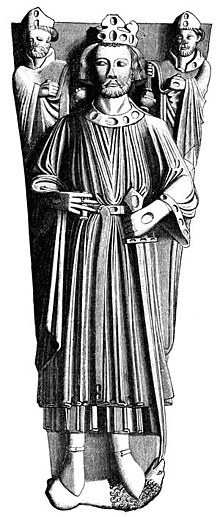
Back Иоанн Адгьылдаратә Abkhazian Jan van Engeland Afrikaans Chuan I d'Anglaterra AN Iohannes Engla Cyning ANG جون (ملك إنجلترا) Arabic جون ملك انجلترا ARZ Xuan I d'Inglaterra AST I Con (İngiltərə kralı) Azerbaijani جان (اینگیلیس) AZB Іаан Беззямельны Byelorussian
| John | |
|---|---|
 Tomb effigy, Worcester Cathedral | |
| King of England | |
| Reign | 27 May 1199 – 19 October 1216 |
| Coronation | 27 May 1199 |
| Predecessor | Richard I |
| Successor | Henry III |
| Born | 24 December 1166 Beaumont Palace, Oxford, England |
| Died | 19 October 1216 (aged 49) Newark Castle, Nottinghamshire, England |
| Burial | Worcester Cathedral, England |
| Spouses | |
| Issue Detail | |
| House | Plantagenet/Angevin[nb 1] |
| Father | Henry II, King of England |
| Mother | Eleanor, Duchess of Aquitaine |
John (24 December 1166 – 19 October 1216) was King of England from 1199 until his death in 1216. He lost the Duchy of Normandy and most of his other French lands to King Philip II of France, resulting in the collapse of the Angevin Empire and contributing to the subsequent growth in power of the French Capetian dynasty during the 13th century. The baronial revolt at the end of John's reign led to the sealing of Magna Carta, a document considered an early step in the evolution of the constitution of the United Kingdom.
John was the youngest son of King Henry II of England and Duchess Eleanor of Aquitaine. He was nicknamed John Lackland (Norman: Jean sans Terre, lit. 'John without land')[2] because he was not expected to inherit significant lands.[3] He became Henry's favourite child following the failed revolt of 1173–1174 by his brothers Henry the Young King, Richard, and Geoffrey against their father. John was appointed Lord of Ireland in 1177 and given lands in England and on the continent. During the reign of his brother Richard I, he unsuccessfully attempted a rebellion against Richard's royal administrators while the King was participating in the Third Crusade, but he was proclaimed king after Richard died in 1199. He came to an agreement with Philip II of France to recognise John's possession of the continental Angevin lands at the peace treaty of Le Goulet in 1200.
When war with France broke out again in 1202, John achieved early victories, but shortages of military resources and his treatment of Norman, Breton, and Anjou nobles resulted in the collapse of his empire in northern France in 1204. He spent much of the next decade attempting to regain these lands, raising huge revenues, reforming his armed forces and rebuilding continental alliances. His judicial reforms had a lasting effect on the English common law system, as well as providing an additional source of revenue. His dispute with Pope Innocent III over the election of Archbishop of Canterbury Stephen Langton led to the Papal interdict of 1208 as well as John's excommunication the following year, a dispute he finally settled in 1213. John's attempt to defeat Philip in 1214 failed because of the French victory over John's allies at the Battle of Bouvines. When he returned to England, John faced a rebellion by many of his barons, who were unhappy with his fiscal policies and his treatment of many of England's most powerful nobles. Magna Carta was drafted as a peace treaty between John and the barons, and agreed in 1215. However, neither side complied with its conditions and civil war broke out shortly afterwards, with the barons aided by Prince Louis of France. It soon descended into a stalemate. John died of dysentery contracted while on campaign in eastern England during late 1216; supporters of his son Henry III went on to achieve victory over Louis and the rebel barons the following year.
Contemporary chroniclers were mostly critical of John's performance as king, and his reign has since been the subject of significant debate and periodic revision by historians from the 16th century onwards. Historian Jim Bradbury has summarised the current historical opinion of John's positive qualities, observing that John is today usually considered a "hard-working administrator, an able man, an able general".[4] Nonetheless, modern historians agree that he also had many faults as king, including what historian Ralph Turner describes as "distasteful, even dangerous personality traits", such as pettiness, spitefulness, and cruelty.[5] These negative qualities provided extensive material for fiction writers in the Victorian era, and John remains a recurring character within Western popular culture, primarily as a villain in Robin Hood folklore.
- ^ Hamilton 2010, p. 1.
- ^ "- Jean sans Terre". www.rct.uk. Retrieved 1 January 2023.
- ^ Norgate (1902), pp. 1–2.
- ^ Bradbury (2007), p. 353.
- ^ Turner, p. 23.
Cite error: There are <ref group=nb> tags on this page, but the references will not show without a {{reflist|group=nb}} template (see the help page).